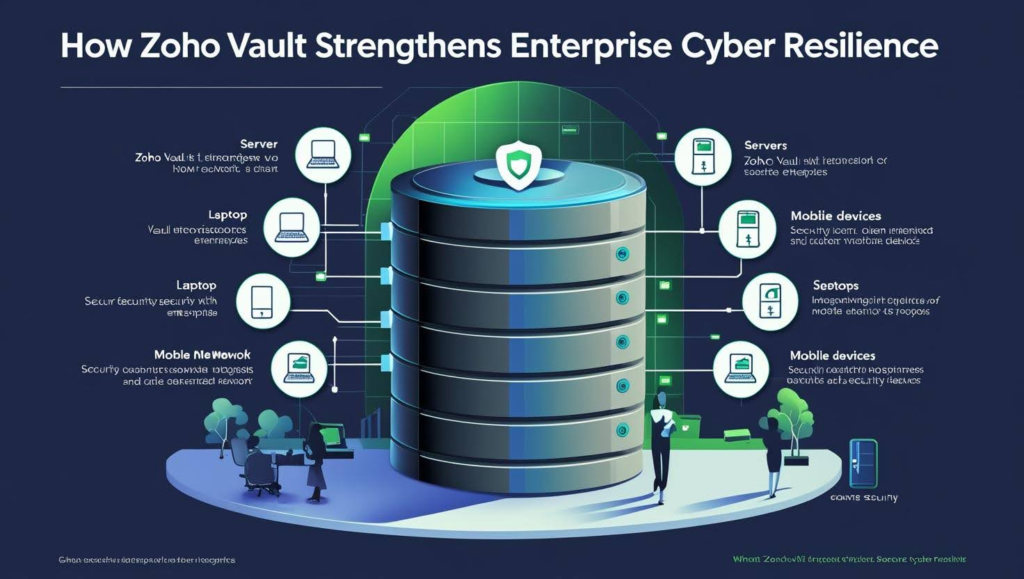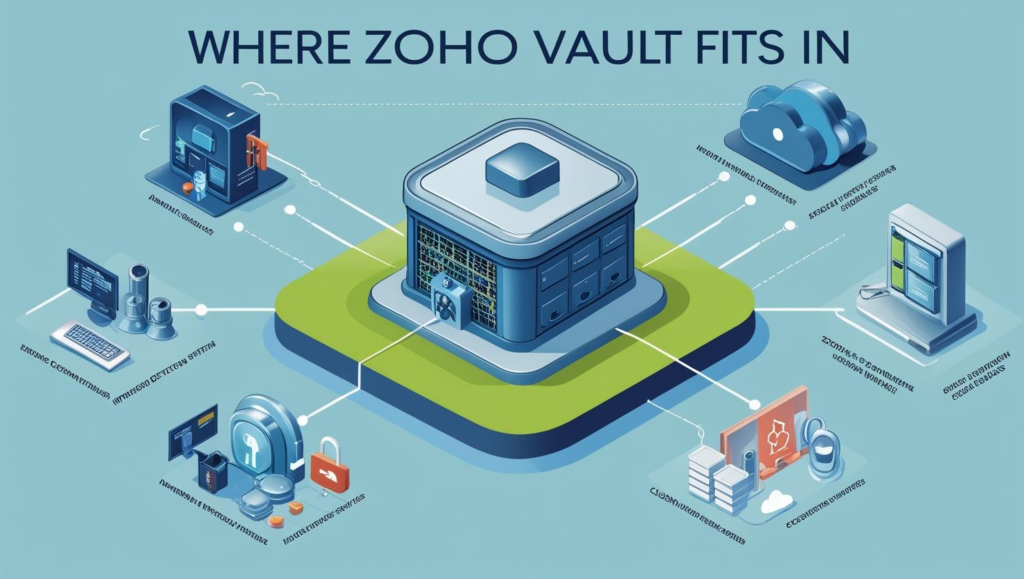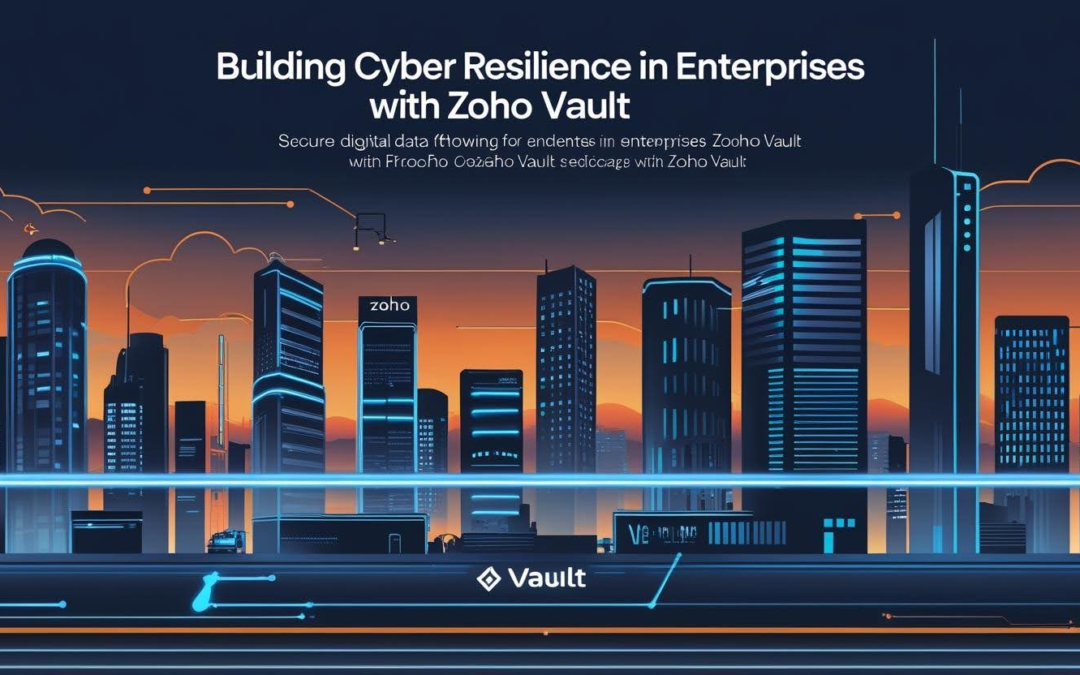Imagine your company working at peak performance on a busy Monday. Suddenly, your network goes down. Files vanish. Systems freeze. An employee unknowingly clicked on a phishing link. Operations stop. Customers wait. Trust erodes.
This scenario is more common than many executives want to admit. In fact, 90% of data breaches start with compromised credentials. It’s not only cybercriminals breaking through firewalls. It’s employees reusing weak passwords, teams sharing credentials over chat apps, or IT managers juggling hundreds of logins with little visibility.
That’s why enterprises now focus not just on cybersecurity but on cyber resilience. Security stops an attack. Resilience ensures your business recovers and keeps moving even under pressure. And at the heart of resilience lies a simple yet powerful element: secure identity and password management.
This is where Zoho Vault, a robust enterprise password manager, comes in. It doesn’t just store passwords; it helps enterprises build resilience, reduce risks, and empower teams with secure yet frictionless access.
Before we dive into the “how,” let’s look at the key takeaways from this article.
Key Points of the Blog
- Cyber resilience goes beyond protection—it ensures business continuity.
- Passwords remain the weakest link in enterprise security.
- Zoho Vault provides a centralized, secure, and efficient way to manage credentials.
- Features like role-based access, secure sharing, audit trails, and integration strengthen enterprise resilience.
- Real-world scenarios show how Zoho Vault supports IT teams, remote workers, and compliance-driven industries.
- Building cyber resilience is as much about culture as it is about tools.
- Zoho Vault is positioned as an essential step toward future-ready enterprise resilience.
Understanding Cyber Resilience Beyond Security
Cybersecurity is like a lock on your door. Cyber resilience, however, is about ensuring you can keep living in your house even if someone breaks the lock, tampers with your system, or cuts the power.
In simple terms: cyber resilience = security + recovery + continuity.
For enterprises, this means not just preventing attacks but adapting quickly when breaches occur, limiting damage, and ensuring smooth operations. Resilience requires preparation, visibility, and intelligent tools that make recovery possible.
And since most breaches begin with poor identity management, resilience starts with passwords.
Passwords: The Weakest Link in Enterprise Security
Even with multi-million-dollar firewalls, many enterprises still rely on spreadsheets, sticky notes, or messaging apps to store and share passwords.
Consider these realities:
- The average employee manages 191 passwords, according to research.
- 65% of people reuse passwords across multiple platforms.
- 80% of breaches involve weak or stolen credentials.
When employees reuse, share, or misplace credentials, the entire organization becomes vulnerable. For large enterprises, where hundreds of systems and SaaS apps are in play, the risks multiply.
This is why enterprises need structured password management. And this is where Zoho Vault steps up.
Introducing Zoho Vault: What It Is and Why It Matters
Zoho Vault is a cloud-based enterprise password manager designed for organizations of all sizes. Think of it as a secure digital vault for your credentials, accessible only to authorized users.
But it’s more than a storage box. Zoho Vault acts as a central control hub for identity management. It empowers teams to store, share, track, and audit credentials without friction. For IT leaders, it offers visibility. For employees, it offers convenience. For compliance officers, it offers assurance.
Zoho Vault matters because it translates a technical necessity—password security—into an organizational strength that directly supports cyber resilience.
How Zoho Vault Strengthens Enterprise Cyber Resilience

Let’s unpack how Zoho Vault builds resilience by addressing key enterprise pain points.
Centralized Password Storage
No more scattered spreadsheets or insecure apps. Zoho Vault stores all enterprise credentials in a single, encrypted vault. This reduces shadow IT and eliminates the risks of lost or unmanaged passwords.
Access Control and User Management
Enterprises often struggle with “who has access to what.” Zoho Vault provides granular control, letting admins assign access to systems based on job roles. This reduces insider threats and unauthorized use.
Role-Based Permissions
Not everyone should have the same access. Zoho Vault allows enterprises to define roles—like admin, manager, or staff—and grant permissions accordingly. This ensures the principle of least privilege, a core component of resilience.
Secure Sharing of Credentials
Teams often share logins, especially for SaaS tools. But sharing credentials via email or chat creates risks. Zoho Vault enables secure credential sharing without exposing the actual password.
Logging and Audit Trails
Resilience requires visibility. Zoho Vault logs every access, change, or sharing event. Audit trails allow enterprises to track suspicious activity, enforce compliance, and respond quickly during incidents.
Integration with Enterprise Workflows
Zoho Vault integrates with tools like Active Directory, G Suite, and Office 365. This ensures that credential management fits naturally into existing enterprise workflows, instead of being an added burden.
Zoho Vault in Action: Real-World Scenarios
For IT Teams Managing Multiple Systems
An IT manager may need to maintain hundreds of servers, databases, and SaaS tools. Zoho Vault provides a centralized dashboard, role-based access, and secure sharing, so the team works efficiently without compromising security.
For Remote and Hybrid Teams
In a hybrid workplace, employees log in from different locations and devices. Zoho Vault ensures they access tools securely without relying on unsafe practices like shared documents.
For Compliance-Heavy Industries
Finance, healthcare, and legal enterprises face strict regulations. Zoho Vault supports compliance by offering encryption, audit trails, and policy enforcement—making audits smoother and reducing penalties.
Comparing Zoho Vault with Traditional Password Practices
Zoho Vault vs Traditional Password Practices
Many enterprises still rely on outdated methods to manage credentials. Let’s compare:
| Traditional Practice | Risk | Zoho Vault Advantage |
| Spreadsheets for storing passwords | Easily stolen, no encryption | AES-256 encrypted central vault |
| Sharing credentials via email/Slack | No control, high chance of leaks | Secure, controlled password sharing |
| Browser-saved passwords | Vulnerable to malware/browser exploits | Enterprise-grade encryption and MFA |
| No audit trails | No visibility, hard to meet compliance | Comprehensive logs and reporting |
Clearly, Zoho Vault offers resilience where traditional practices fail.
Building a Cyber-Resilient Culture with Zoho Vault
Technology is only one side of resilience. Culture is the other. Employees must adopt secure practices, and leaders must encourage accountability. Zoho Vault helps by:
- Reducing friction in secure access, making compliance easy.
- Offering visibility that encourages responsible behavior.
- Empowering teams to collaborate securely without resistance.
When employees see security as simple rather than restrictive, resilience becomes part of the culture.
Future of Cyber Resilience: Where Zoho Vault Fits In

The future will bring more threats, more devices, and more complexity. Enterprises need scalable tools that adapt. Zoho Vault is cloud-based, continuously updated, and integrates with other Zoho tools as well as third-party apps.
This makes it future-proof. It evolves with enterprise needs, ensuring resilience is not a one-time achievement but an ongoing capability.
Conclusion: Why Enterprises Need Zoho Vault Now
Cyber resilience is not optional. It’s the backbone of modern enterprises. Passwords remain the most exploited weakness, and ignoring them puts entire organizations at risk.
Zoho Vault transforms password management from a liability into a strength. It provides centralized control, secure sharing, audit-ready visibility, and cultural adoption. It doesn’t just secure data—it keeps enterprises moving when attacks strike.
Enterprises that adopt Zoho Vault don’t just manage passwords. They build resilience, ensure continuity, and strengthen trust with every login.
The question is not whether you need Zoho Vault, but how soon you can make it part of your cyber resilience strategy.

